Henan (河南 - Hénán - «to the south of the river") - a province in east-central China, one of the cradles of Chinese culture. In the province are the most important archaeological sites: the ancient fortress Peyligan (age - 7000 years), Yangshao (6000 years) and Dahe (5000 years). Over the many thousand-years of history of Chinese civilization more than 20 dynasties established or moved their capitals of their States in Henan. Three of the seven ancient capitals of China are in Henan province - is Luoyang, Kaifeng and Anyang. In addition, there are the cultural and historical cities of the state level: Nanyang, Shangqiu and Zhengzhou. Ancient Chinese states - Xia Dynasty (third millennium BC.) and Shang-Yin also originated in the territory of Henan.
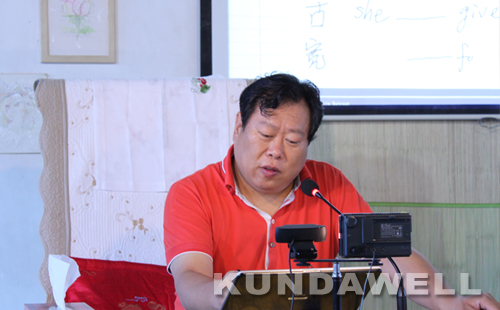
Lectures and workshops of Master Xu Mingtang held at the School of Shaolin Wu shu "Da Gou".
All participants of the retreat – are students of Xu Mingtang, practicing Zhong Yuan Qigong and Image therapy. As a rule, on the first group comes newbies, and on the second - the students, who many years practice together with the Master, some of them never missed a retreats.
Retreat - it is an opportunity to practice with the Teacher two or three weeks away from the city and society, completely immerse in the energies, the wise leadership and assistance of Teacher, in an area which is the cradle of Chinese culture, the birthplace of the great spiritual masters, among the mystical, beautiful with high energy mountains and valleys, it's also a deep immersion into Chinese culture - visiting a large number of monasteries located in the Shaolin area, communication with the monks in the monasteries of the Buddhist and Taoist traditions, participation in temple ceremonies, etc.
All days are very eventful - a morning practice Qigong or Tai Chi, classes with Master Xu Mingtang, independent practice in the mountains, monasteries (Favansi, Yountaisi and others) in Taoist temples Chzhunyuemyao, in the Temple of the Three Emperors, in the cave of Damo and others, joint visits to the Luoyang city - Buddhist "White Horse Temple", the cave "The Dragon Gate", climb up the Mountain Sōng Shān...
Coming back from the retreat, participants always feel themself full of energy, vital and spirit force, more wise and calm, after the practice of "Bigu shi chi" (the practice of not eating), more slender, rejuvenated.
In order to cover everything that happened in the retreat, require more than one material.
But even these few pictures and descriptions help to feel the atmosphere.
 |
During retreat, the great importance is attached to the self practice - in temples, mountains.
|
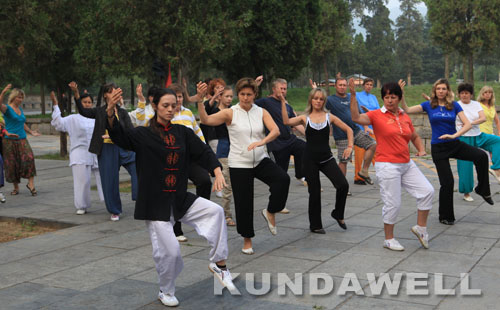 |
In the mornings, in front of Shaolin studied Tai Chi Chuan, health complex Ba Duan Jing. |
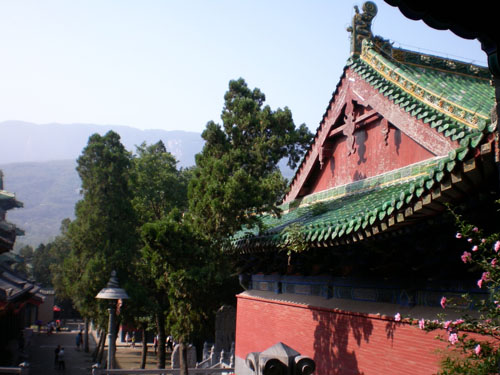 |
Practiced and meditated a lot in the Shaolin monastery, in its surroundings. |
Shaolin (Shao Lin Si translated from Chinese means "monastery in the forest on the mountain Shao") founded by a group of Buddhist monks led by the Indian teacher Bato in spring 495, on the holy Sōng Shān Mountain in Henan Province. The monastery is known around the world as the cradle of Chan (Zen)-Buddhism and over 200 directions of martial arts.
In the 6th century, according to legend, to Shaolin came Bodhidharma - the founder of a new branch of Buddhism - Chan (or Zen in Japanese). It was Bodhidharma who showed to monks 18 fighting movements that initiated all Shaolin Kung Fu. As a result, of daily religious practice and martial arts trainings, monks reached higher states of Liberty and became almost invincible. Northern Shaolin is associated in people's minds with the origin of the phenomenon of "Shaolin training system".
The valley, where is located a Shaolin, stretched severely from east to west and wonderfully combines spaciousness, breadth and solitude. These places from of old have a reputation of fairy, mystical, suitable for communicating with spirits and esoteric practices.
Shaolin - is, in the mind of every Chinese, the birthplace of Chan (Zen) Buddhism, which has the basic method - "direct comprehension" of reality "from heart to heart, not on the basis of written symbols".
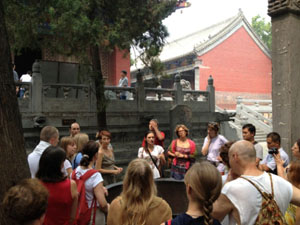 |
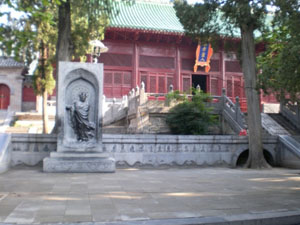 |
For those who visit Shaolin for the first time, Daria Patoka (a pupil of Master Xu Mingtang) always very inspiredly guides tours on the monastery, explains in details the meaning and traditions of each hall, tells about the real person, emperors and gods, to whom people worship in these halls.
 |
In spare time watching performances of Shaolin’s Wu shu. |
Visited the Buddhist "White Horse Temple", cave "The Dragon Gate" (the city of Luoyang);
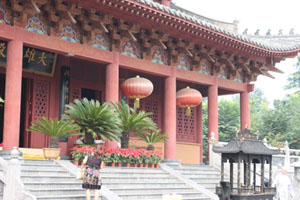 |
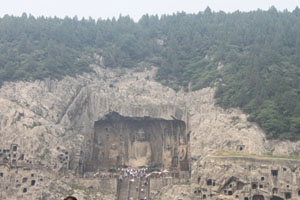 |
| The Buddhist "White Horse Temple" |
Caves "The Dragon Gate" |
Climbed up Sōng Shān Mountain.
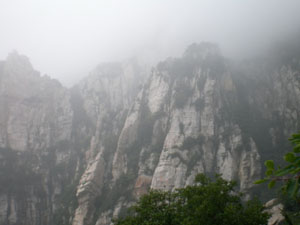
|
Sōng Shān - is one of the five sacred mountains in Chinese Taoism. It is located in Dengfeng district, Henan Province, on the southern shore of the Yellow River. Sōng Shān Mountain is a few peaks that rise to a height of 1,500 meters above sea level. Near mountains locates Luoyang, the "capital of nine dynasties".
The Chinese mythology states about Sōng Shān Mountains: there was a road of an ancient emperor Yu, suppressor of unruly waters. Even before the Buddhist monks, Taoists and hermits settled here, Confucian academies and universities existed here, the famous observatory has survived to our time, and the area was called Shu Yuan - book courtyard. It is also known that in the old days in the Sōng Shān Mountains, there were 72 Temples (some exist even now - monasteries Favansi, Yountaysi, Lienhuasi, Taoist temples Chzhunyuemyao, Laomugun etc.). |
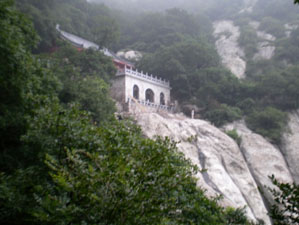 |
 |
| Monastery in the mountains. Before it opens a deep gorge. |
The top of Sōng Shān Mountain - 1491.73 mOn the left - "Stone of desires". One who has reached the top, can touch the stone and make a wish.
|
Annual traditional photo of all retreat participants.
 |
Participants of the 15th retreat in Shaolin |
Returning from Shaolin in Beijing, participants of the retreat always come in "Kundawell", were for many students passed memorable months or years of study.
On the 23-d of August celebrated the end of the retreat with singing and dancing, and remembered Shaolin practice and adventures. Thanked Institute "Kundawell" for the warm welcome and attentive service.
Two or three days before going home usually devoted to visitation of the cultural and historical sites of Beijing: Tiananmen Square, Forbidden City, Lama Temple Yong Hegun, Great Wall, Summer Palace of the Emperor, and others.
in detail:
- About Henan Province, Sōng Shān Mountains, Luoyang, etc.
- About Shaolin and other cultural and historical monuments in Henan Province (we translate)
|
